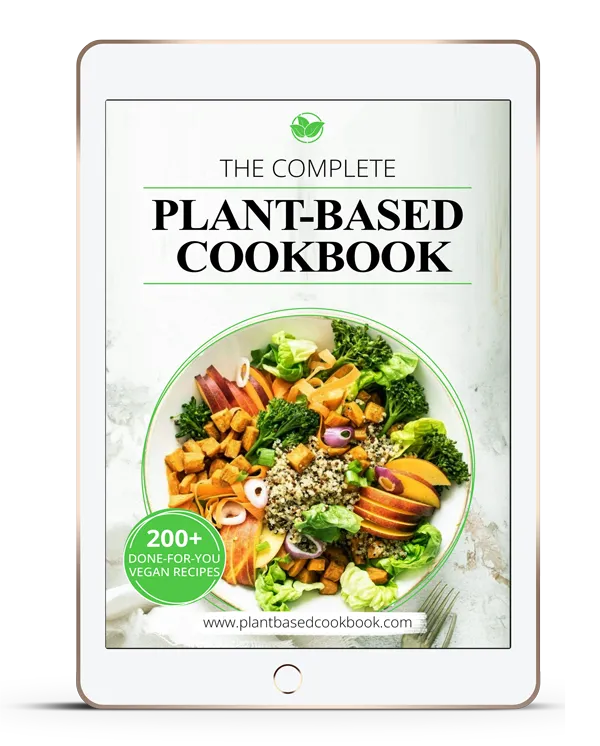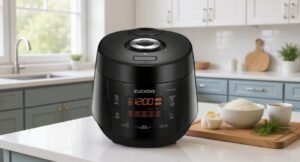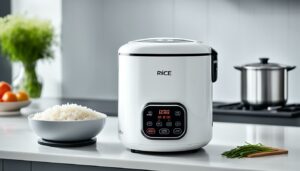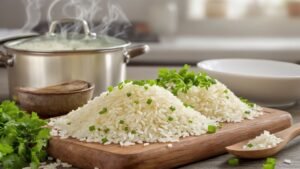We’re going to cut through the rice cooker confusion once and for all. Short grain rice isn’t just “any rice”—it’s the foundation of proper Asian cuisine, and most people butcher it completely. Your rice cooker isn’t magic, but master these five core techniques and you’ll produce restaurant-quality results every time. The difference between mushy disappointment and perfect, sticky grains? Precision beats guesswork.
Table of Contents
ToggleEssential Equipment and Ingredients for Perfect Short Grain Rice
Three pieces of equipment will make or break your short grain rice game: a dedicated rice cooker, a proper rice measuring cup, and your sink for rinsing.
We’re talking Koshihikari or similar short grain rice varieties that deliver that coveted sticky texture essential for Japanese dishes. Your rice cooker handles the cooking process while you focus on precision.
That 180ml measuring cup isn’t optional—accurate water measurement separates amateurs from pros. The rice-to-water ratio sits at 1:1.1 or 1:1.2, depending on your stickiness preference.
Rinsing rice 2-3 times until water runs clear removes excess starch. Period.
Washing and Polishing Your Rice Grains
Two fundamental steps separate mediocre rice from restaurant-quality perfection: washing and polishing your grains with surgical precision.
We’re removing excess starch that transforms short grain rice into gooey mush—the texture nightmare haunting countless kitchens.
Measure your rice, cover with water one inch above grains. Rub vigorously between palms until water runs milky white. Drain. Repeat. Again.
We rinse the rice three times minimum—no shortcuts allowed. Clear water signals victory over impurities.
This polishing ritual isn’t optional ceremony; it’s mandatory preparation for your rice cooker.
Skip this step? Enjoy sticky disappointment. Follow through? Achieve restaurant-quality cooking results every single time.
Water Ratios and Soaking Techniques
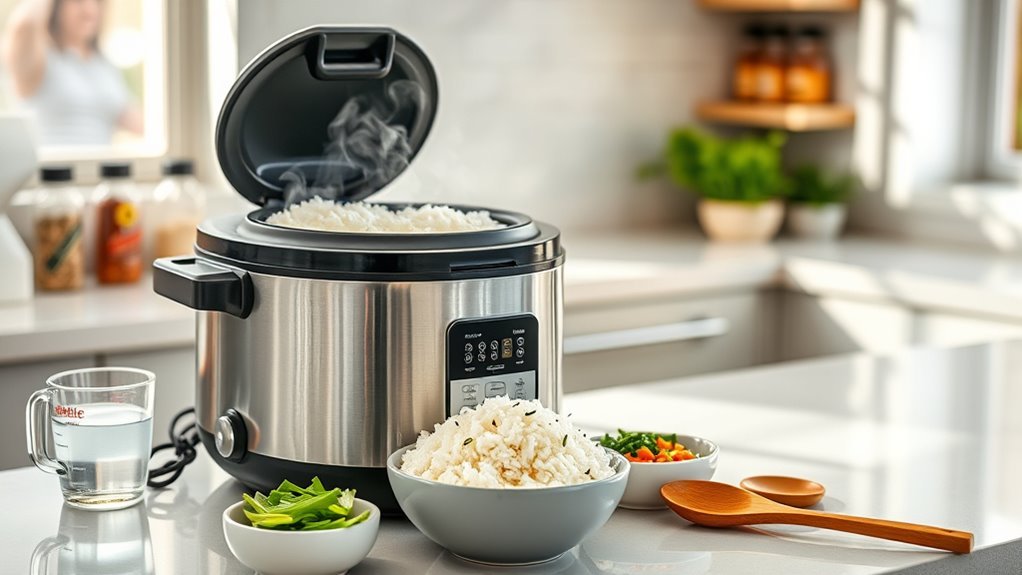
Perfect washing sets the foundation—now we’re commanding water ratios with scientific precision. Short grain rice demands a 1:1.1 ratio—one cup rice to 1.1 cups water. This isn’t negotiable.
| Rice Amount | Water Amount | Soaking Time |
|---|---|---|
| 1 cup | 1.1 cups | 20-30 minutes |
| 2 cups | 2.2 cups | 20-30 minutes |
Before cooking, soak your rice directly in the rice cooker. Cover with water, wait 20-30 minutes. This soaking amplifies moisture absorption, transforming texture from mediocre to magnificent. Your rice becomes perfectly tender, never gummy. If results seem too firm, add two tablespoons more water next round. Precision breeds perfection.
Operating Your Rice Cooker for Optimal Results
Once we’ve mastered the ratios, operating your rice cooker becomes a streamlined process that demands attention to detail.
First, measure rice using the designated cup—remember, it’s 180ml, not your standard American cup. Rinse rice relentlessly until water runs clear; excess starch is your enemy.
Know your machine’s cooking programs; short-grain rice often needs specific settings. Hit start, then resist temptation to peek.
When it’s done, let the steam process continue for ten minutes. This waiting period isn’t optional—it’s what separates amateur rice from ideal results. Your patience pays dividends in texture.
Fluffing and Serving Your Perfectly Cooked Rice
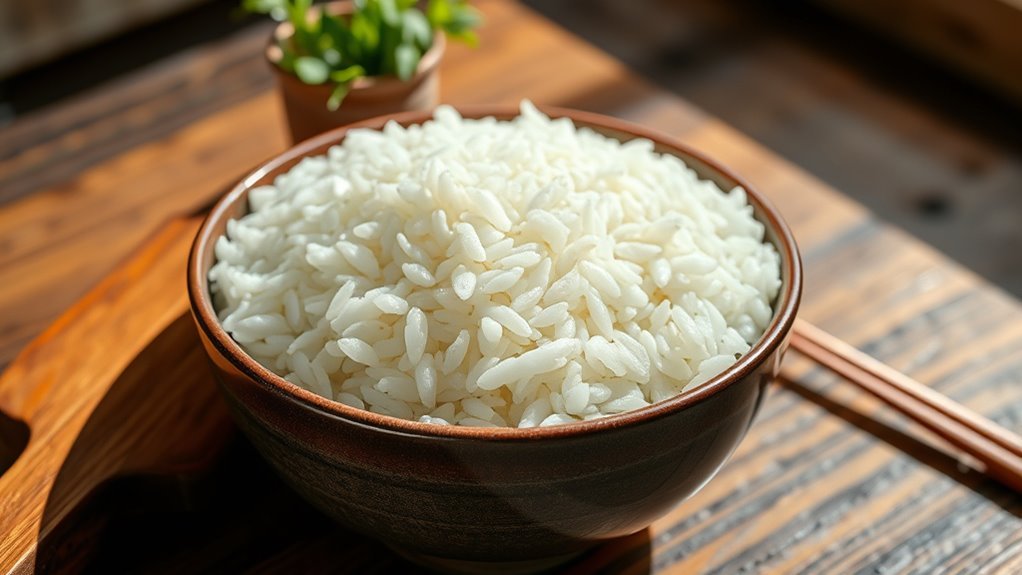
After that essential ten-minute rest, we’re ready to transform steamed grains into restaurant-quality rice.
Grab your rice paddle—never a spoon—and gently fluff by lifting and separating without crushing. Think surgical precision, not aggressive stirring. Your rice cooker delivered perfectly steamed texture; don’t ruin it now.
For sushi rice, fold seasoned vinegar through gently. Serving immediately? Smart move. Freshly fluffed beats day-old every time.
Got leftovers? Refrigerate in an airtight container. When reheating, add water drops to restore moisture. Remember: respect those grains. They’ve been through enough.
Your fluffing technique separates amateur cooks from rice masters.
Frequently Asked Questions
What Is the Ratio of Water to Rice When Cooking Short-Grain Rice?
Perfect rice texture hangs in the balance—we’ll use a 1:1.1 to 1:1.2 water-to-rice ratio for ideal water absorption. These preparation techniques guarantee consistent cook time and superior rice texture across different rice varieties.
Does Short-Grain Rice Cook Differently?
Yes, we’ll find short-grain rice requires different cooking methods due to its unique texture. Its higher starch content creates stickiness that’s culturally significant in Asian cuisines, offering distinct flavor profiles compared to long-grain varieties.
Is It 1 Cup of Rice to 2 Cups of Water in a Rice Cooker?
Don’t throw caution to the wind with water ratios! We recommend 1:1.1 or 1:1.2 for short-grain rice, not 1:2. That’d create mushy rice texture. Proper water ratios guarantee perfect cooking times and ideal results.
How to Cook Multi-Grain Rice in a Rice Cooker?
We’ll rinse multi-grain rice, soak thirty minutes, then use 1.5-2 cups water per cup rice. These cooking techniques improve rice texture and reveal nutritional benefits while different rice varieties create complex flavor profiles.


